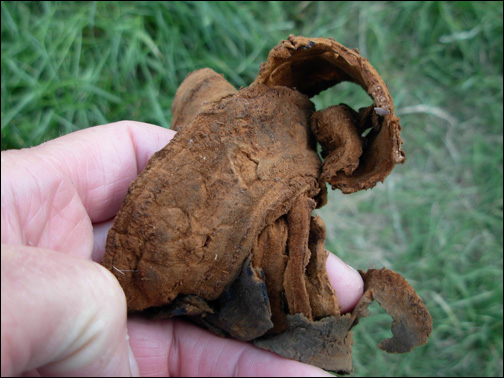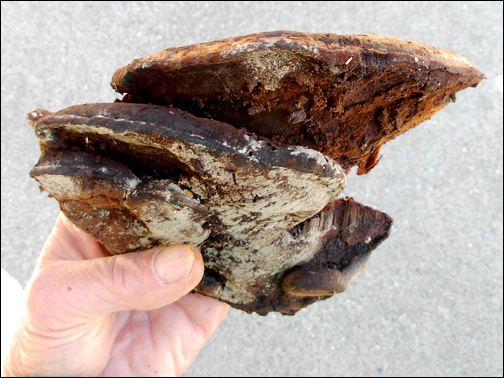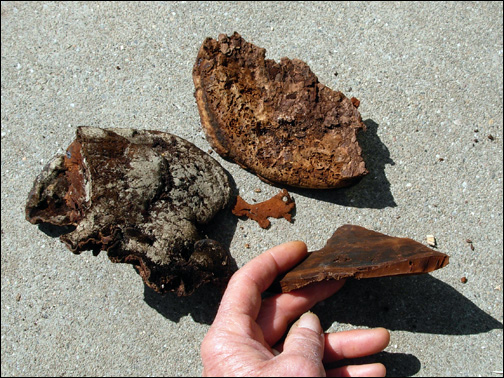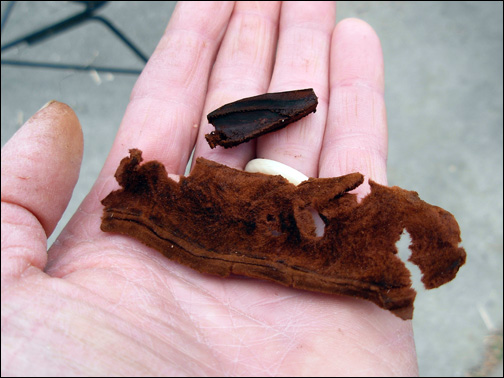
by Susan Labiste

Fomes fomentarius isn’t the only conk capable of producing amadou.
Photo by Robert A. Blanchette
There is much said about ideal tinder, and a much touted one is amadou. Amadou is the fluffy felt-like material obtained from a woody shelf fungus or “conk”, more specifically from” tinder fungus” (Fomes fomentarius). This stuff is capable of catching the spark from steel or marcasite without the need for charring. Amadou has obtained the status of myth, and I will admit to both my own amazement the first time I saw it used and to my disappointment that the conk from which it is made depends mostly on Birch as a host. Birch does not grow in California where I live. Since then I have been searching for a substitute for Fomes fomentarius closer to home.
Why Amadou? Effectiveness and History

This tinder of backwoods fame is made from the conk commonly known as ”tinder fungus”. Conk is the common term for most hard shelf fungi, usually from the genus Ganoderma, Fomitopsis or Phellinus. Amadou is the term for the sliced and processed conk, and it has the feel of soft buckskin.
To appreciate amadou one has to realize how difficult it can be to obtain really good tinder material in the wild. I’m talking about tinder that will catch a spark without first being charred. Most flint and steel enthusiasts use charred punk wood, charred cotton cloth, or charred plant pith. Unless you carry some form of charcloth in the field with you, you have to first make a fire to make the charcloth. If you are relying on flint and steel or flint and pyrite for that fire, you are in a bit of a fix without charcloth. So, it’s useful to know about tinders that work without charring. Amadou isn’t the only good tinder, but it sure is an appealing one.
Another part of Amadou’s appeal is its place in the history of fire. Traditionally it is produced by just one fungus. The Latin name for this fungus is Fomes fomentarius. Common names can be confusing. The term tinder fungus is also used to describe Inonotus obliquus (chaga), and the common name false tinder fungus is applied to both Fomes fomentarius and to Phellinus igniarius. I will include the Latin terms to avoid confusion.
In Europe, back in the day when flint and steel started your fire, “German tinder” was a piece of amadou improved by the addition of potassium nitrate (salt peter). The source for this salt came from soiled straw from stable heaps where the urea in urine underwent bacterial decomposition to form first calcium nitrite, then eventually calcium nitrate. Water was poured through the heap, collected, then filtered through white wood ash (containing potassium carbonate). The calcium nitrate salt converts to potassium nitrate as it reacts with the potassium carbonate. This nitrate rich solution was then decanted, sopped up with the amadou, then dried. The folks who made the tinder didn’t necessarily know the chemistry, but they sure knew how to make tinder “quick”, quick to catch fire that is. Natural sources of potassium nitrate crystals can sometimes be collected directly from bat cave walls and old stables.
Amadou had other uses. It has an amazing ability to absorb moisture. Dentists once used it to dry teeth before a blast of air came into vogue. Podiatrists used it to pack the sides of toenails prone to inflammation. It has been used to staunch bleeding and to serve as a wound dressing. Fly fishermen can be found to this day using it to dry fishing flies. It has medicinal qualities, was used as a razor strop, and it is even used to make smoking hats . . . . wait, a flammable hat for smoking? What were those Germans thinking?
It was in use before recorded history. In 1991 a late neolithic man melted out of a glacier in the Otzal region of the Italian Alps. Otzi, as he came to be named, carried tinder fungus (Fomes fomentarius). He may have carried it for its medicinal qualities, but his knife shows traces of marcasite, so he apparently used the knife as a striker in his pyrite/flint fire kit. The last time he used the kit was 5,400 years ago. Most likely he needed the amadou he carried to kindle a fire in such a cold alpine winter environment.
Making Amadou From Fomes Fomentarius
My first real experience making amadou came from Jose Martinez Amoedo at the 2010 Rabbitstick Rendezvous. I missed his talk on the subject, as I was teaching my own class, but he was kind enough to tell me about the process individually. He collects from North American forests, specifically from birch trees. First, he soaks the fungus in water to soften it if it is not already fresh and flexible.
The outer layer of this conk is quite hard, even after soaking. It is a job to pare it away, kind of like peeling a nut shell off nutmeat. All this has to be done without damaging the useful material below. The inner portion consists of both a corky material and a layer of tubes. The tubes are also removed and usually discarded. However, this tube portion can be cut up and used as the wick of a fat lamp. Jose likes to use olive oil as the fuel. He says the amadou wick never burns up.
Jose calls the layer between tubes and the thin outer covering the “leather”. It is also called the trauma. This is the portion best suited to catching a spark. Once this portion is isolated, the moist tissue can be sliced, then pulled and flexed gently until it fluffs up and expands to about twice or three times its original size. Most of the expansion is lateral, and it tends to pull apart along the lines of “growth rings” in the fungus. It becomes quite light and retains flexibility, even when dry. It feels like very soft brain-tanned leather. The color also resembles brain-tanned leather with its rich tawny browns. This Fomes amadou can be used as is, but Jose puts it in a char-cloth burning box and reduces it to charcoal. Top quality amadou retains its flexibility even after charring. It acts like charcloth, but appears to be far more easily ignited than charcloth. In fact, Jose’s amadou charcloth lit on the first strike and was nearly impossible to put out. Jose’ tells me he learned how to process amadou from Mors Kochansky, guru of the boreal forest.
Links on How to Make Amadou From Fomes fomentarius
Rather than providing directions on how to make amadou using tinder fungus, this article focuses on substitute fungi. But if birch trees grow near where you live, you might want to make some amadou from Fomes fomentarius. Here are some websites with decent photos and more elaborate descriptions of the process of making amadou from Fomes fomentarius. They contain pretty good photos of the trauma layer, and will help you distinguish this layer in other conks as well.
If you visit these sites, you will notice quite a bit of variation in the technique and the definition of amadou. For me, the term implies a felt has been produced, but the term is also applied to the fluffy material created by simply abrading the trauma layer without the trouble of processing it into a felt.
http://www.wildwoodsurvival.com/_jthy/viewtopic.php?f=5&t=218
http://www.bushcraftuk.com/forum/showthread.php?t=8071&p=109464&highlight=#post109464
http://paulkirtley.co.uk/2011/easy-way-to-use-fomes-fomentarius-as-tinder/
The Search for an Alternate Amadou Source
Well, I clearly had fallen in love with the stuff. It has a tactile appeal that makes you want to carry it around with you and rub it on your face. A friend in Michigan sent me some Fomes fomentarius, and I delighted in creating my own amadou. But where was I going to get more without pestering my friend for shipments? Was there any conk-type fungus growing locally that would produce a decent amadou substitute?
So this set me on the path, literally, to try our local Coastal Central California conks and to see if they could produce amadou of a quality to rival the amadou from Fomes fomentarius. I wanted something field-ready, not something I would have to process at home prior to needing it. And I wanted it to catch a spark without charring. For those of you living elsewhere, our conks may inhabit your woods too, as their spores travel widely. They are common in many areas of the country, and they or their relatives are spread world-wide.
Theories on Why Amadou Works
First off, I had a suspicion that the magic of fire with amadou was the same magic that made it so soft and light. Though some folks insist its success in catching a spark has to do with the flammability of birch bark, I think it may be all about the fibers . . . . or at least mostly about the fibers.
Anyone familiar with lighting a campfire understands that as the fire’s heat increases and combustion is more robust, we add larger pieces of fuel. The concept applies well to kindling and tinder. Taking this concept and applying it to diminishing heat sources, it becomes clear smaller heat sources require smaller pieces of fuel.
If tinder is defined as that material which catches and holds the first spark allowing it to expand, then by extrapolation it’s success depends primarily on the minute size of individual combustible fibers (fuel) and their exposure to air. You want enough air space between fibers to allow for the oxygen demands of the combustion. Lots of little fibers in a fluffy mass means each bit of combustible material is exposed to oxygen rich air. Think of fluffiness as an ideal relationship between surface area and proximity of each fiber to its neighboring fiber. You want exposure to air, but not so much distance between fibers that the heat dissipates before combustion spreads. You also don’t want flare-ups or explosions that exhaust the fuel immediately. This relationship between fuel size, the proximity between fibers and available oxygen is what allows your spark to grow into an ember, and ember to flame.
You can see this in the choice of popular tinder such as cattail fluff or cottonwood down. If you have had experience with these, you may already have discovered that the degree to which they are fluffed or compressed affects the way the ember behaves.
Another related effect of fluffiness is the way it actually “catches” the spark. Even highly flammable surfaces fail if the spark simply bounces off.
The question becomes, which shelf fungi can be processed into that ideal balance of fiber size and spacing, so it both catches the spark, and feeds it.
Successful Experiments with Local Conks

Oak Conk (Phellinus gilvus) produced an excellent amadou tinder.
In March 2011, I found what appeared to be an old Oak Conk (Phellinus gilvus) growing on a sycamore tree. Identification was based on its growth form, host, the size of the pores and the thin, dark pore layer. Identification of conks is still new to me, so I can’t be 100% sure of the ID. It was so blackened and bug riddled with age that identification should wait until it fruits from the same tree again, but that didn’t happen this year.
The conk was composed of three stacked shelves expanding from the tree. It was removed at the base and the three shelves were separated easily with a little prying. The top surface of each shelf showed signs of insect activity and was partially eaten away with holes and insect frass visible. The underside of each was black with signs of decay in the form of white patches of mold. This was not an ideal specimen. It was far too dry and brittle to cut slices from it dry.
I soaked it in a bucket and found it entirely saturated, submerged on the bottom 48 hours later. The tube layer was a half inch to a quarter of an inch in thickness and this was pared away. The disintegrating top surface was also removed. This isolated a layer of tissue that was tough, but corky. It lacked the tubular structures of the reproductive layer and it didn’t have the friable and brittle texture of the upper surface. You might compare it to the rubber found in the soles of certain inexpensive shoes or “flip-flops”. In Fomes fomentarius (tinder fungus), this would be called the trauma layer. Unlike Fomes fomentarius, the trauma layer was very dark brown, nearly black prior to processing. Compared to removing the trauma from an old fomes fomenatrius, this fungus was a total piece of cake! It took less than 5 minutes to isolate the potentially useful layer. Anyone who has tried to pare off the walnut-shell-hard surface of Fomes fomentarius knows it isn’t a 5 minute job . . . . even after soaking.

A slice was then made vertically along the outer edge of the wet conk. By outer edge, I mean the "lip” edge farthest from the tree. To clarify, if it were still attached to the tree, the cut was oriented top to bottom (sky to earth) and followed the curve of the outer edge. This left me with a dark chocolate colored piece of conk about an eighth of an inch thick.
This cut orientation proved significant. Vertical cuts were more successful than horizontal cuts or radial cuts. The fibers of the trauma layer on my Phellinus spp. conk tended to separate during processing along lines running from the tree in a fan shape, spreading outward toward the lip of the conk. When sliced vertically across this “grain”, processing produced separation of fibers, resulting in a spongy material full of microscopic holes. When cut with the grain (a horizontal line along the fibers radiating outward from its connection to the tree) the material was more prone to splitting and fraying during manipulation.
This sliced-off piece was still wet. It was stiff, but could be dented with a fingernail easily. Very light pounding for 15-30 seconds changed its consistency from belt leather to that of a bike’s rubber tube. This so-called “pounding” is a deceptive word as it was more like tapping. Imagine you wanted your kid brother’s attention immediately,but didn’t want him to say ”ouch!”
I allowed it to dry to a barely moist stage, then manipulated gently. GENTLY! You aren’t going to believe how gently. Try it gently, then when it breaks, try again more gently. Hold it between both hands, between thumbs and first fingers. The distance between thumbs will be less than an eighth of an inch (nearly touching). Barely move it up, down and side to side. When you feel it loosen up, stretch very gently. The piece should be damp, but not soaking wet. This is important, because a sopping wet piece can’t fluff up with air, so it doesn’t respond the same way. As it is drying, manipulate it in your fingers to encourage it to expand and work air into spaces between the fibers. It grows and becomes foamy in texture. I didn’t spend more than 5 minutes total transforming that slice of material from bike tube consistency to a foamy sheet much larger than the piece I started with. I stopped working it temporarily when it no longer expanded as I manipulated it. It was still damp enough to feel cool when touched to my lower lip.

I found the biggest mistake was to rush it by being too rough. This is a very gentle process for this species. When completely dry, it should have the consistency of thin and supple brain-tanned buckskin. Actually, I thought it felt more like a velour blanket. After teasing air into it, the piece should be well over twice the area of the original piece. Like buckskin, it will become stiffer as it dries unless it is stretched and worked until there is little or no moisture left. “Working” a hide is hard work. “Working” the trauma layer of this conk when it is sliced thin and has been lightly pounded is more like massaging a caterpillar with the expectation that the little guy will thank you afterward. And, you don’t have to work continuously the entire time it dries. Just be sure it doesn’t dry completely on its own without your help.
I did lose sections of it during processing. Some either frayed or contained hard spots that needed to be removed. But the expansion of the material as it was worked still left me with a larger slice than what I started with. If you find this teasing apart process isn’t going well, do not despair. Allow the shredded pieces to dry a little, then pound it intermittently as it dries until it is fluffy. The resultant fluff can be used just like amadou and just pinch of it under your thumb may be enough to get a spark going. Or, you can pile it up and drop sparks into it. Including drying time, I had my tinder in less than half an hour after slicing the wet conk. If using a fresh, growing conk, the soaking process could be eliminated, or at least require far less time.
When do you know you have succeeded in getting your “amadou” dry enough? When it no longer feels cool, if touched to your lower lip.
Now my Phellinus amadou was ready for a try out. I gently abraded the surface to raise up fibers. It felt like velour or velvet now and was extremely light and supple. I folded it under my thumb on top of my flint. The second pass with the steel striker produced a puff of smoke. I tipped my thumb up to gently blow life into a spark and was pleased to note the ember was robust enough to resist two attempts to put it out.
Of course, I had to perform multiple tests to be sure I wasn’t just lucky. Now I can be sure it works, and I’m feeling down right extravagant with the stuff. In terms of performance, it compared well to top notch Fomes fomentarius amadou. In terms of consistency or “feel”, it was less leathery than Fomes amadou, and extremely light.
![]()
All photographs by Susan Labiste, except the photo by Robert A. Blanchette. All photo rights reserved.
We hope the information on the PrimitiveWays website is both instructional and enjoyable. Understand that no warranty or guarantee is included. We expect adults to act responsibly and children to be supervised by a responsible adult. If you use the information on this site to create your own projects or if you try techniques described on PrimitiveWays, behave in accordance with applicable laws, and think about the sustainability of natural resources. Using tools or techniques described on PrimitiveWays can be dangerous with exposure to heavy, sharp or pointed objects, fire, stone tools and hazards present in outdoor settings. Without proper care and caution, or if done incorrectly, there is a risk of property damage, personal injury or even death. So, be advised: Anyone using any information provided on the PrimitiveWays website assumes responsibility for using proper care and caution to protect property, the life, health and safety of himself or herself and all others. He or she expressly assumes all risk of harm or damage to all persons or property proximately caused by the use of this information.
© PrimitiveWays 2016